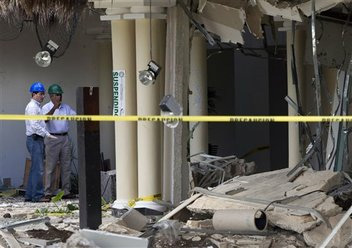
|  |  |  News Around the Republic of Mexico News Around the Republic of Mexico  
Sewer Gas May be Behind Deadly Mexico Hotel Blast
 Gabriel Alcocer - Associated Press Gabriel Alcocer - Associated Press
go to original
November 17, 2010


| | Workers survey the damage caused by an explosion at the Grand Princess Riviera Hotel in Playa del Carmen, Mexico, Tuesday Nov. 16, 2010. (AP/The Canadian Press/Jonathan Hayward) |  |
Cancun, Mexico — New evidence discovered Tuesday suggests an accumulation of sewage gases may have caused the weekend explosion at a seaside resort that killed five Canadian tourists and two Mexican workers, officials said Tuesday.

Authorities had previously said swamp gases produced by rotting vegetable matter trapped beneath the hotel's ground floor might have triggered Sunday's explosion.

Investigators said Tuesday they discovered a ruptured sewer line about 10 yards (meters) from the area where the blast erupted under the floor of a lounge area at the Grand Riviera Princess resort. But officials said it was too early to determine the definitive cause of the explosion at the 676-room hotel in Playa del Carmen, south of Cancun.

"The investigation is focused on the possibility that leaks and an accumulation of waste water in the foundations could have caused the concentrations of methane, which could have caused this explosion," said Felix Gonzalez Canto, governor of southeastern Quintana Roo, where the resort is located.

On Monday, officials noted the resort had been built partly over an area of former mangrove thickets and said that perhaps explosive swamp gases produced by rotting vegetation might have been trapped beneath the ground floor.

Experts say both sewage and rotting sediment from mangroves could produce methane, and Canto left open the possibility the explosion might have resulted from a combination of sewage gas and swamp gas.

Canto said the investigation was continuing and it was too early to speculate about possible negligence by the hotel.

The blast blew out windows in a lounge area, littering the lawn with shards of glass and metal debris, and left behind a crater 3 feet (1 meter) deep.

A hotel worker who answered the phone at the Grand Riviera Princess said all managers were in a meeting and could not be reached for comment.

Inspectors from the army, navy and civil defense agencies combed through the rubble looking for clues in the accident.

Meanwhile, the bodies of four of the five Canadian victims had been released to relatives to be returned to Canada, Quintana Roo's state public prosecutor's office said in a statement Tuesday.

Playa del Carmen's civil defense director has requested new equipment capable of detecting methane and plans to check other hotels in the area.

Jesus Puc, who is responsible for safety inspections in the area, said no gas was detected in an inspection of the Grand Riviera Princess four or five months ago, but the inspectors' equipment was designed to sense cooking gas.

Tourism to Mexico, the nation's No. 3 source of foreign revenue, has only recently begun recovering from a downturn caused by soaring drug violence, last year's swine flu epidemic and the world economic crisis.

Associated Press writer Rob Gillies in Toronto contributed to this report.
|

 |
|  |



